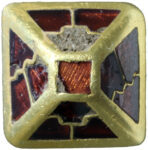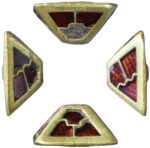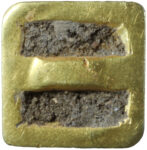 An Early Anglo-Saxon pyramidal mount with cloisonné inlay garnets has been discovered in the Breckland area of Norfolk by a metal detectorist. The rare object dates to between about 560 and 630 A.D., when the counties of Norfolk and Suffolk formed the independent Kingdom of East Anglia in the aftermath of the Anglo-Saxon settlement of Britain.
An Early Anglo-Saxon pyramidal mount with cloisonné inlay garnets has been discovered in the Breckland area of Norfolk by a metal detectorist. The rare object dates to between about 560 and 630 A.D., when the counties of Norfolk and Suffolk formed the independent Kingdom of East Anglia in the aftermath of the Anglo-Saxon settlement of Britain.
A petite piece at 12mm x 11.9mm (0.4in x 0.4in), the gold pyramid has a square base and is inlaid on all four sides with three cloisonné garnets in two different styles on opposite sides: a stepped t-shape and a diagonal t  with a wavy crossbar. The pyramid has a flat square top with a single cloisonné garnet. The borders between the pyramid’s facets are much thicker than the slim lines that divide the cells on the sides. The garnets have waffle-pattern foil backing, a technique often seen in Anglo-Saxon jewelry (e.g., the Staffordshire Hoard). One of the garnets on the side is missing and some of the others have suffered cracking and chipping. They are all of either Indian or Sri Lankan origin. Under the base of the pyramid is a slightly convex crossing the middle. The inside of the pyramid is hollow and currently full of soil.
with a wavy crossbar. The pyramid has a flat square top with a single cloisonné garnet. The borders between the pyramid’s facets are much thicker than the slim lines that divide the cells on the sides. The garnets have waffle-pattern foil backing, a technique often seen in Anglo-Saxon jewelry (e.g., the Staffordshire Hoard). One of the garnets on the side is missing and some of the others have suffered cracking and chipping. They are all of either Indian or Sri Lankan origin. Under the base of the pyramid is a slightly convex crossing the middle. The inside of the pyramid is hollow and currently full of soil.
[Finds liaison officer Helen] Geake said: “It would have been owned by somebody in the entourage of a great lord or Anglo-Saxon king, and he would have been a lord or king who might have found his way into the history books.
“They or their lord had access to gold and garnets and to high craftsmanship.”
 While Anglo-Saxon pyramidal mounts have been found before — primarily as one-off finds rather than in a funerary context — it’s not entirely clear what their function was or where exactly they were mounted. The bar crossing the underside suggests it may have been a scabbard mount, used to secure the sword into the scabbard by threading the strap through the bar on the base of the pyramid
While Anglo-Saxon pyramidal mounts have been found before — primarily as one-off finds rather than in a funerary context — it’s not entirely clear what their function was or where exactly they were mounted. The bar crossing the underside suggests it may have been a scabbard mount, used to secure the sword into the scabbard by threading the strap through the bar on the base of the pyramid
Pyramidal mounts were created and used from the late 6th century until the early 8th. They went from short, squat pyramids on square bases to taller, slimmer versions with a variety of shapes including circular, hexagonal and octagonal. The recently-discovered example is from the early period.